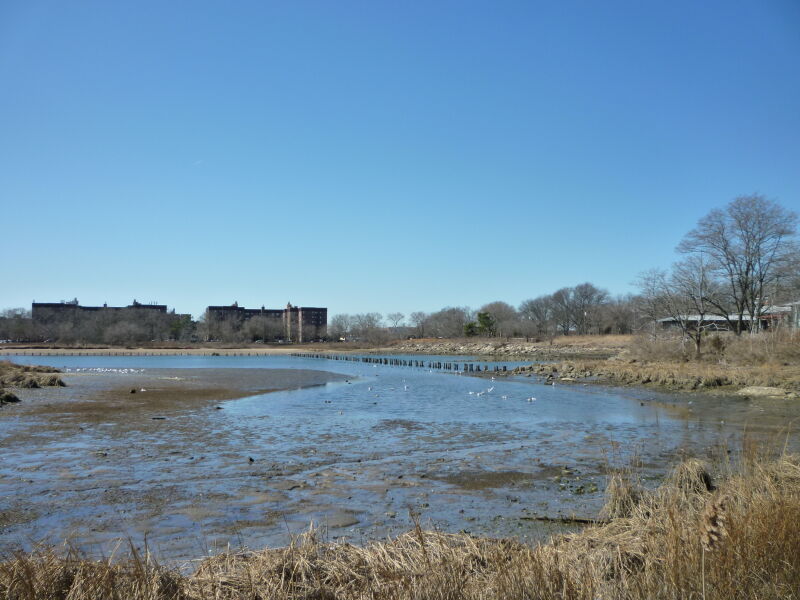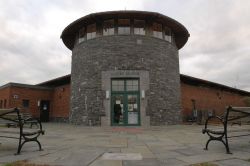Marine Park
Marine Park - Salt Marshes in New York City Parks
Salt marshes play a critical role in the support of human life, acting as natural filtration systems by trapping pollutants that would otherwise contaminate our bays and oceans. Salt marshes have the ability to absorb fertilizers, improve water quality, and reduce erosion. They are also among the richest wildlife habitats.
Most of Marine Park’s 798 acres consist of salt marshes and uplands that flank Gerritsen Creek, the westernmost inlet of Jamaica Bay. Jamaica Bay is an 18,000-acre wetland estuary that provides a unique environment for both wildlife preservation and urban recreation. Enclosed by the Rockaway Peninsula and protected from the Atlantic Ocean, the region currently hosts over 325 species of birds, 50 species of butterflies, and 100 species of finfish. A favorite stop for migratory waterfowl, the area is an integral part of the larger, regional ecosystem.
When the last of the glaciers melted 7,000 years ago, the oceans rose to their present levels. Sediments washed from the land were deposited offshore in narrow sandy strips, forming long islands parallel to the shoreline. These barrier beaches received the pounding surf on their ocean side, but had calm, protected bays behind their landward shores. While the waters were calm enough for vegetation to take root, the presence of saltwater made survival difficult. One species, however, saltmarsh cordgrass (Spartina alterniflora), was able to colonize the flat expanses of sand and silt, which were covered twice a day by the ocean’s tides. Today, the grass is still found along the Atlantic coast.
As this specialized grass spreads, its stems trap floating debris. Sediments and particles of decaying matter slowly build up, forming nutrient-rich mud. This mud, called detritus, supports life on the marsh. It is the basis of a complex food web in which energy is passed from one organism to another. The fiddler crab (Uca) and ribbed mussel (Geukensia demissa) have developed a mutually beneficial relationship with the cordgrass. While the crabs and mussels benefit from feeding on decaying matter trapped within cordgrass roots, cordgrass gains from the fiddler’s burrowing, which aerates the soil, and the mussel’s excretion, which provides necessary nitrogen.
At the end of each season, the cordgrass dies, creating a spongy peat. Each year’s peat layer raises the surface of the marsh, enabling it to colonize new territory. A variety of plants with less salt tolerance can colonize the peat, as it is out of the range of most of the high tides. This causes the formation of two separate plant communities, the intertidal marsh and the salt meadow. A third type of salt marsh community is the mudflat. Each of these communities has its own distinctive vegetation, insects, fish, birds, and mammals that have adapted to survive in a saltwater environment. While salt marshes do not have a very wide variety of species, the volume of life present is remarkable.
Broad expanses of fertile salt marsh, meadows adorned with wildflowers, sandy dunes held in place by beach plants, and jungle-like thickets of shrubs and vines dominate the landscape of Marine Park. Myrtle warblers (Dendroica coronata), grasshopper sparrows (Ammodramus savannarum), cotton-tailed rabbits (Sylvilagus floridanus), ring-necked pheasants (Phasianus colchicus), horseshoe crabs (Limulus polyphemus), and oyster toadfish (Opsanus tau) are a small sampling of the animals that inhabit these plant communities and live in or around Gerritsen Creek. Marine Park’s sheltered creek attracts a wide variety of marsh birds. From June through August, clapper rails (Rallus longirostrus) can be heard calling throughout the marsh. In winter, freshwater and marine waterfowl find shelter in the creek. Winter visitors include greater (Aythya marila) and lesser (Aythya affinis) scaup, ruddy duck (Oxyura jamaicensis), mute swan (Cignus olor), Canada goose (Branta canadensis), and common loon (Gavia immer).
Since industrialization, human activity has destroyed many marshes. Where marshes are disturbed, common reed (Phragmites australis) often grows in place of cordgrass. Since reeds do not decompose into as nutritious a substance as cordgrass, a reed marsh does not contribute as much to coastal ecosystems as a cordgrass marsh. In the last 200 years, humans have also filled over 80 percent of the city’s original salt marshes for construction. While recent conservation efforts have improved the condition of marshes, this valuable ecosystem continues to disappear from the City at an alarming rate. Scientists fear that the salt marshes in Jamaica Bay may vanish within 20 years.
Check out your park's Vital Signs
Clean & Safe
Green & Resilient
Empowered & Engaged Users
Share your feedback or learn more about how this park is part of a
Vital Park System










